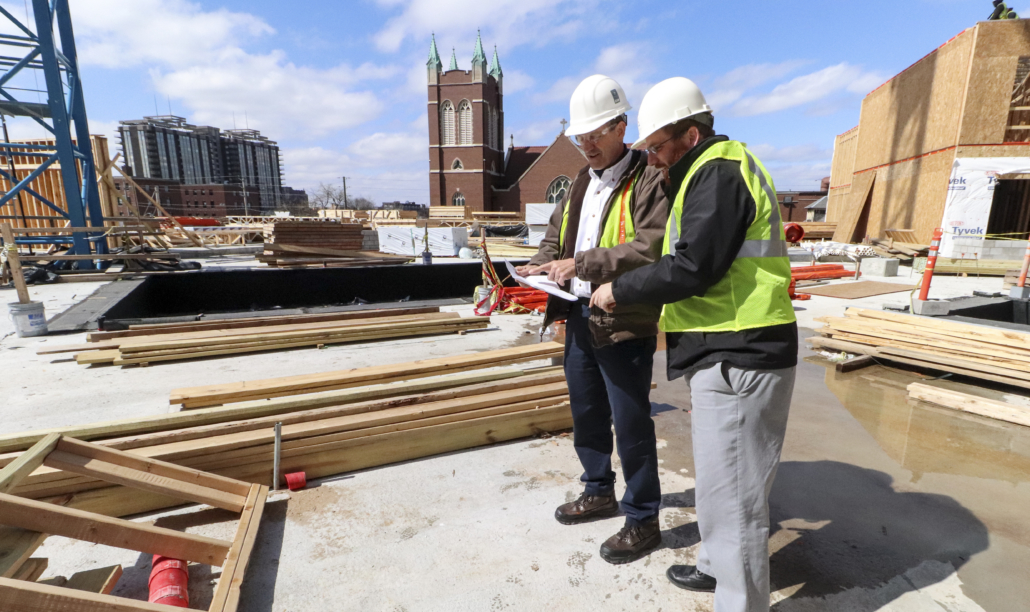Choosing a Construction Delivery Method for K-12 Building Projects
-
Category
Studio-K12, Innovation -
Posted By
Schmidt Associates -
Posted On
Oct 14, 2019
If you’re starting your first building or renovation project in your district—or even your first project in a long time—there can be a hefty learning curve. The processes are nuanced, there are endless acronyms and industry jargon, and many different people and organizations are involved.
For even the savviest of school administrators, it can be a very complicated and high-pressure process, especially when using public funds. One of the most important, and potentially difficult, decisions you’ll need to make during your project is which method of construction delivery to use.
What is Construction Delivery?
“Construction delivery” refers to the way in which the construction process is managed and services rendered in order to complete the project. There are a variety of construction delivery methods to choose from, and the one you decide on will determine the steps in the process and your role throughout.
In K-12 school construction projects, Owners typically use one of three common construction delivery methods: Construction Manager as Adviser (CMa), Construction Manager as Constructor (CMc), and Design-Bid-Build (DBB) without a construction manager.
There are several additional construction delivery methods, but we’ll focus on these three most common. To learn about other construction delivery methods, check out our e-magazine.
Role of a Construction Manager
Two of the three construction delivery methods we’ll discuss involve a construction manager (CM). The CM is hired by the project Owner (you) to be the point person who organizes and oversees all aspects of a construction project. This includes:
- Managing the project schedule, including design and construction
- Managing the project budget, including preparing cost estimates during the design process
- Organizing and administering the bidding process
- Serving as the primary point of communication and a liaison between contractors and the architecture/engineering (A/E) firm(s) that designed the building
- Ensuring contractors construct the building according to the exact specifications of the design drawings
- Working with the A/E to review construction work for quality assurance
A CM is essentially a middle man between all major players in the process. They work on behalf of the Owner and are deeply involved in the day-to-day aspects of construction.
When deciding if you need a CM, carefully consider who on your staff would manage the project otherwise. Does this person have recent experience managing complex construction projects and their many details and nuances? Does this person have excellent communication, organization, and project management skills? Does this person have the necessary knowledge of various disciplines involved, including electrical, mechanical, HVAC, carpentry, etc., to be able to oversee such work? And perhaps most importantly, does this person have the time available to manage the construction process in addition to his/her regular duties?
![]()
Construction Manager as Adviser (CMa)
What is it?
In this construction delivery method, the CMa performs all functions described above. While the CMa organizes the bidding process and manages the construction process, the Owner contracts directly with the contractors. Typically, the Owner will hold contracts with five to 10 different contractors chosen to complete the construction.
When do you choose it?
CMa is often used for larger, more complex projects—typically over $5 million. A CMa is paid a fee separate from the construction costs. This is typically 4-8% of the total construction cost. The Owner is essentially paying for a trusted adviser to guide them through the project.
What is your role as the Owner?
As the Owner in the CMa method, you hold the contracts with each contractor. This gives you control over the contractors, as well as the CMa and A/E. It also means you assume the risk associated with those contractual relationships.
Construction Manager as Constructor (CMc)
What is it?
In this method, also known as Construction Manager at Risk (CMAR), the CMc performs all functions described above. However, instead of the contractors being contracted with the Owner, they are contracted with the CMc. The CMc is paid a fee for pre-construction services, as well as a management fee, typically 4-8% of the total construction cost. In CMc, a Guaranteed Maximum Price (GMP) for the cost of construction can also be used.
This method of construction delivery has been used on privately funded projects in Indiana for many years. Recently, Indiana law changed to permit CMc on publicly funded projects, including public schools. There are specific provisions that must be followed when using CMc.
When do you choose it?
Like the CMa method, CMc allows the Owner to step out of the day-to-day of the construction process by entrusting an experienced party to coordinate and oversee the work. The CMc method transfers the contractual authority and risk to the CMc. This is attractive to many Owners. CMc is often used on projects that require multiple phases of construction, have tight schedules, or have special site constraints.
What is your role as the Owner?
CMc allows you to step back further from the construction process, as you do not hold the contracts with the contractors. You are only contracted with the CMc and A/E. In this method, it’s important to establish the process in which construction costs are determined as part of the selection of the CMc.
![]()
Design-Bid-Build (DBB) without a CM
What is it?
DBB is the most traditional method of construction delivery. “Design-Bid-Build” describes the sequence of the project: the design is completed; the construction work is competitively bid by contractors; and the lowest, most responsive bidder is chosen. Usually, DBB involves the Owner contracting with one prime contractor—typically a general contractor, or GC—who is responsible for managing all construction activities.
The A/E prepares the design, administers the bidding process, and monitors the construction through its construction administration services. The A/E is not considered the CM, however, and does not have all of the same responsibilities.
When do you choose it?
Not all projects warrant a CM. Smaller, simpler, lower-budget projects do not require pre-construction services, phasing of construction, or as much paperwork and management as larger projects do. In these cases, a GC can typically get the job done.
DBB is a good option for projects less than $5 million. It is also good for projects that have a relatively straightforward timeline—for example, if work can be completed during summer break—or if the project involves a new building separate from an existing school.
What is your role as the Owner?
The GC is responsible for coordination and communication of construction activities throughout the process. They hold the contracts with sub-contractors and are responsible for the management of cost and schedule. As the Owner, you are responsible for providing the GC with information and decisions in a timely manner to keep the schedule on track. Owners sometimes supplement this by hiring a Clerk of the Works (CoW) or adding Extended Services from their A/E firm.
When to Use Extended Services
As a full-service A/E firm, Schmidt Associates provides Owners with Extended Services when needed. Extended Services can include a host of specific tasks during the construction process that typically fall under a CM’s responsibilities. The A/E firm can step in to fill any of these gaps if the Owner deems it necessary.
We recommend utilizing Extended Services when you or your staff do not have the experience or the capacity to oversee certain aspects of the construction process not covered by your GC in a DBB project or other construction delivery method.
The basic construction administration service our firm provides includes A/E representation at the construction site an average of one day a week. Adding Extended Services allows you to customize services to receive a higher level of site presence. This could be anywhere from one additional day a week to full-time on site. This gives you a proactive presence from the A/E to address contractor issues and review the quality of the work as it’s completed.
Questions? Check out our e-magazine for more details, or contact us to connect with our construction administration professionals.








